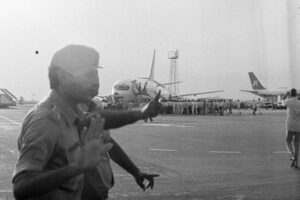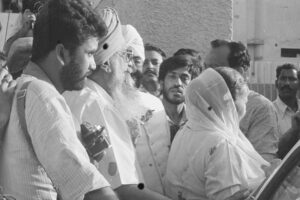Lifestyle
IC 814 Hijack: Unveiling the Real Story Behind the High-Stakes Negotiations to Save 176 Lives
IC 814 Hijack: Unveiling the Real Story Behind the High-Stakes Negotiations to Save 176 Lives
About the hijacking that took place almost a quarter century ago, who could have thought it would raise such a tempest? The newly released Netflix miniseries IC 814: The Kandahar Hijack certainly stirred up a whirlwind. Much of this criticism was against the making of a traumatic event into entertainment-a trauma which the world witnessed with 176 passengers and crew.
The motive for hijacking Indian Airlines Flight IC 814 in 1999 was not a mystery: The hijackers conducted the operation to result in the release of one of Pakistan’s most infamous jihadist commanders, Masood Azhar. The negotiations, spearheaded by then-national security adviser Ajit Doval, seemed to suggest a deal could be brokered by releasing just Azhar himself. “If we’d had whisky there, we’d have popped the bottle,” recalls a senior government official about the brief optimism that surrounded the talks.
But then, things started getting even more complex when the Taliban introduced more demands. Believed by many to have been instigated by Pakistan’s ISI, those extra conditions prolonged the agony of the passengers beyond the initial eight days. The hijackers had issued an initial list of demands that included the release of 31 individuals from Indian jails and a $25 million payout. Those demands were pared down over time, but the process was slow, since Ramzan restricted negotiations to nighttime sessions-after dinner-end.
The Indian government finally yielded to the key demands after unending negotiations: the release of Masood Azhar, who later formed the militant group Jaish-e-Mohammad; Omar Saeed Sheikh, a British-born terrorist involved in the journalist Daniel Pearl murder case; and Kashmiri militant leader Mushtaq Ahmed Zargar. Releasing them was a huge compromise, indicating the level of pressure the Indian negotiators felt.

The miniseries has come under much criticism-most particularly from former intelligence officers-due to its point of view on how certain events played out. A major bone of contention is a scene where an Afghan official seems to consult with Osama Bin Laden; some officials say this shifts blame away from the ISI. Some also accuse Adrian Levy of having spun the story to diffuse the blame from the ISI in this case, as he had been in company with these people while researching his book Spy Stories: Inside the Secret World of the R.A.W. and the ISI, which he co-authored.
Officials insist the hijacking was unequivocally engineered by Masood Azhar’s brother and supported by the ISI. “We knew 15 minutes after the hijacking that the group was affiliated with Azhar and that his release would be their number one demand,” one official insists. In fact, an association between Azhar and the ISI was well defined in the intelligence made available to the Indian sleuths who had foiled several plans hatched earlier with the objective of securing Azhar’s release.
Some also criticized the miniseries for apparently diffusing the identities of the hijackers-who, on the show, bear common Hindu names. Netflix, since then, has revised the disclaimer of the series to reflect that, in fact, the real names of the hijackers were Pakistani. The hijackers being portrayed as somewhat humane has also been a point of contention, though some passengers remember small acts of kindness during the ordeal, including celebrating a passenger’s birthday.

The program has also been criticized for sensationalizing the rescue operation which could have been attempted. Former R&AW chief A.S. Dulat has faulted the crisis management group of the Indian government while other senior officials pointed out that such operations are by no means easy to plan or execute and need very careful assessment of the location and condition of the hijackers. The faraway location of the plane in Kandahar from the relief plane themselves posed serious obstacles to the rescue operation.
Furthermore, ex-R&AW officers are also critical about the torture scenes and the interpolated events, such as one Nepalese intelligence officer being tortured to confess knowledge of the presence of an RDX-filled bag in that plane. Ex-cabinet Secretary Anand Arni has said that there was no serious warning regarding hijacking, and his presentation about the initially armed items carried by hijackers as knives corresponds to the real event.
One of the closely guarded secrets during the hijacking was that Swiss-Italian Roberto Giori, who was the director of De La Rue-Giori-a company that was key in the design of banknotes-was aboard the plane. His presence there was kept secret to ensure he was not brought into danger, and his name was never published.
It questions the internal conflicts the show portrays-for instance, the way a journalist pressurizes an editor to expose sensitive information. Real life’s first priority was the safety of the passengers, and there was hardly room for that kind of conflict.
The series dramatizes the brutal hijacking and grueling negotiations with minor quibbles. Scenes lifted from a book, Flight into Fear: The Captain’s Story by Devi Sharan and Srinjoy Chowdhury, dramatically show the scenes of this great event. The bravery of the 14-member crew and 162 passengers, including the chilling murder of honeymooner Rupin Katyal, shows the strength of the passengers in extreme pressure.
Also Read: Exploring the Meaning Behind Teacher’s Day 2024
While the miniseries was a subject of debate and controversy, respectively, it also reminded viewers of this dramatic and convoluted crisis management during one of the most challenging episodes in recent Indian history. The passengers’ ordeal and the response by Indian authorities remained the subjects of reflection and discussion both on-screen and off-screen.
Source: The Telegraph












